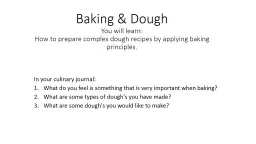

You will learn How to prepare complex dough recipes by applying baking principles In your culinary journal What do you feel is something that is very important when baking What are some types of doughs you have made ID: 270572
Download Presentation The PPT/PDF document "Baking & Dough" is the property of its rightful owner. Permission is granted to download and print the materials on this web site for personal, non-commercial use only, and to display it on your personal computer provided you do not modify the materials and that you retain all copyright notices contained in the materials. By downloading content from our website, you accept the terms of this agreement.
Slide1
Baking & DoughYou will learn:How to prepare complex dough recipes by applying baking principles.
In your culinary journal:
What do you feel is something that is very important when baking?
What are some types of dough's you have made?
What are some dough's you would like to make?Slide2
Baking: Basic IngredientsBaking Formulas: Have been developed using exact types of , if the formula is not followed precisely, the products
will be affected.Slide3
Basic IngredientsGluten:Firm elastic substance that affects the of baked products. The higher the flours
content the more potential it has to form gluten.
Gluten Replacement:
Crumb:
The internal of a baked productSlide4
Basic Ingredients: FlourThe proteins and starch in flour give structure.Examples:B flour
Soft Wheat flour
flourCake flour
flourSlide5
Basic Ingredients: LiquidsLiquids are essential in baking. Too water to a pie dough will cause
gluten formation with may result in a
texture.Examples:
EggsSugar syrupsbutterSlide6
Basic Ingredients: FatsFats surround or enclose the flour particles and prevent long strands of gluten forming. This the baked goods as well as adding
.
For example:
Oil
MargarineSlide7
Basic Ingredients: Sugars & SweetenersSugars and sweeteners add a sweet, pleasant flavor to baked products as well as:Slide8
Basic Ingredients: Sugars & SweetenersTypes of:MolassesBrown sugar
Turbinado
sugar
Coarse sugar
Superfine sugar
Corn syrupMaple syruphoneySlide9
Basic Ingredients: EggsSecond most important ingredient in baked products. They add:Structure & thickenerEmulsification-
Aeration-
FlavourColour
-
Slide10
Basic Ingredients: Leavening AgentCauses baked goods to by introducing Carbon Dioxide or other gases into the mixture. The gases expand from the heat of the oven, stretching the cell walls in the baked product. The end result is a
For Example:
Air
Steam
YeastSlide11
Basic Ingredients: SaltEnhances the product through its own flavor as well as bringing out the flavor of other ingredients. Salt also acts on gluten and results in acceptable texture.Slide12
Basic Ingredients: FlavouringEnhance the flavor of the final baked good influencing the baking process.
For example:
Slide13
Basic Ingredients: DoughContains less liquid than a batter, making it easy to work with your
. Doughs may even be stiff enough to cut into
. Doughs are formed when the dry and liquid ingredients are combined to create products. Slide14
Mixing Methods: Beating ingredients vigorously to add
or develop gluten.
Use: spoon, electric or bench mixer with paddle attachment.Slide15
Mixing Methods: Blending two or more ingredients together until they are evenly
.
Use: Spoon, whisk, rubber spatula, or bench mixer with paddle attachment for blending.Slide16
Mixing Methods: Creaming
Use: Electric or bench mixer with paddle attachment on medium speedSlide17
Mixing Methods: Cut InMix solid
with
until lumps of the desired size remain.
Use: Pastry cutter, bench mixer and paddle attachment, two knives, or fingers.Slide18
Mixing Methods: FoldingGently adding light, airy ingredients such as to
ingredients by using a smooth circular movement.
Use: spoon or handsSlide19
Mixing Methods: KneadingWorking the dough to develop and evenly
ingredients.
Use: hands or bench mixer with dough hookSlide20
Mixing Methods: SiftingPassing dry ingredients such as flour through a
to remove lumps, blend and add air.
Use: Rotary sifter, or mesh strainer by tapping the side over your bowl.
You will learn:
How to prepare complex dough recipes by applying baking principles.Slide21
Mixing Methods: Stirring blending the ingredients until combined.
Use: spoon, rubber spatula or whiskSlide22
Mixing Methods: WhippingVigorously beating ingredients to .
Use: whisk, electric or bench mixer with whipping attachment.Slide23
BISCUITS!!!How to make?Watch videoSlide24
BISCUITS: What makes a good biscuit?Appearance: Color:
Crumb:
Texture:
*Separates into layers
Flavour
: * Bitter flavor? Too much baking powder.
What can we add?Slide25
BISCUITSHow do we serve biscuits?